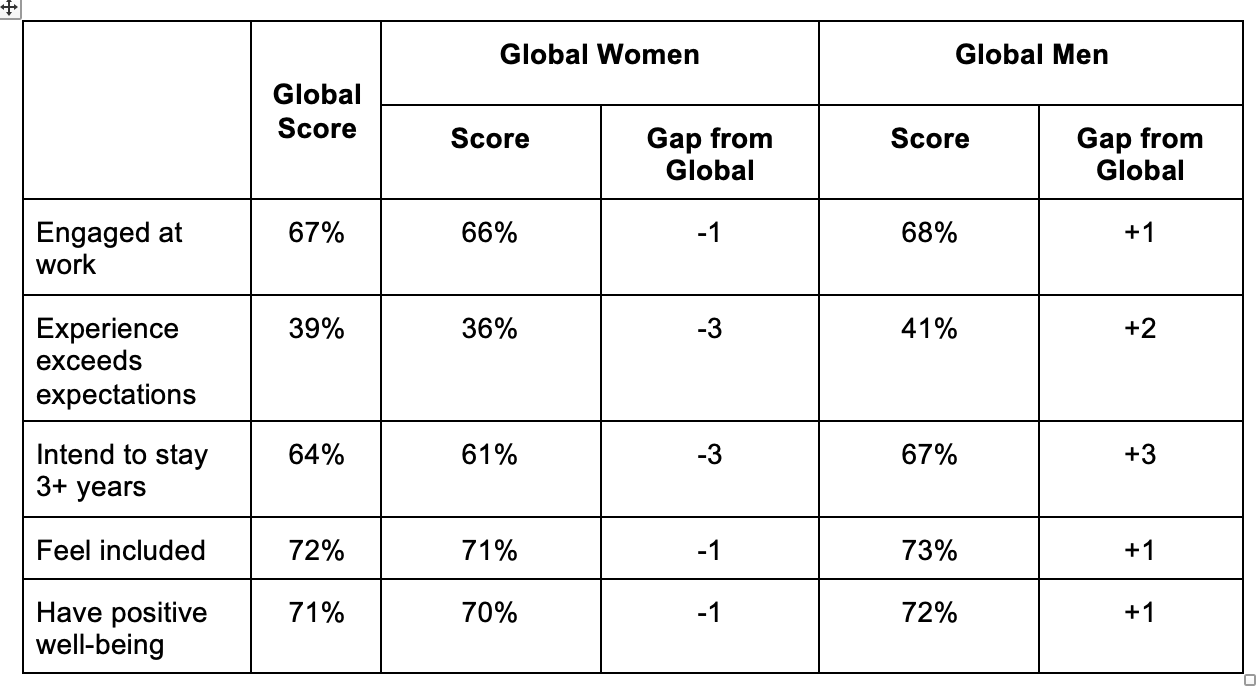Similar Values, Separate Outcomes: Qualtrics Data Reveals Persistent Gender Experience Gaps at Work
Last updated: March 8, 2023
Despite increasing attention and efforts aimed at leveling the playing field at work, men consistently report having more positive employee experiences
QUALTRICS X4, SALT LAKE CITY, March 8, 2023 – In the United States, labor force participation rates for women have recovered at a faster pace than men’s have, but similar improvements have not been seen in their overall experience in the workplace, according to a new data analysis from Qualtrics. In the 2023 Employee Experience Trends Report, respondents who identify as men consistently say they have more positive experiences at work than women do.
Women were more likely to leave the workforce during COVID[1], a result of being more likely to work in impacted industries and roles, as well as taking on more caretaking responsibilities at home.
For International Women’s Day, Qualtrics analyzed data on how the employee experience differs for workers by gender and role seniority. This research reveals critical insights as leadership teams work to build diverse and equitable workforces.
“While many senior leaders are making real efforts to build more diverse, equitable and inclusive organizations, to be successful they must be intentional in understanding the experiences of different employee segments, especially those who are marginalized or underrepresented,” said Dr. Cecelia Herbert, Principal Catalyst at Qualtrics XM Institute. “This should be given the same focus as other strategic priorities, because diverse teams that engage with a fair and inclusive culture are the key to a company’s competitive advantage. When leaders listen to these employees, and take action based on their insights, they can begin to craft a future where both employees and organizations can thrive.”
Drivers of positive employee experiences are consistent across genders
Men consistently have more positive employee experiences than women do. In fact, the gap between women’s intent to stay and men’s is growing, as is how well their overall experience meets their expectations.
Recognizing the most impactful drivers of employee experiences can help leaders focus their efforts to create equitable workplaces.
Key factors that drive a positive employee experience for women at work are:
● Believing their career goals can be met at the company
● Having good opportunities to learn and develop
● Feeling supported in efforts to adapt to organizational changes
● When the company helps them understand how changes will affect their work
● Work processes that allow them to be as productive as possible
These factors are relatively consistent across genders, signaling that people are more similar than different when it comes to what drives them at work. However, men consistently say they have more positive experiences with these drivers, suggesting that their employee needs are being better met.
Global regional differences are revealed at higher job levels
Across the globe, senior leaders – those at the director level and higher – report having the most positive employee experiences of all job levels. But leaders in the Asia-Pacific region have a notably different experience by gender than leaders in North America and Europe, Middle East and Africa (EMEA) region do.
In some Asia-Pacific countries, women leaders rate their experiences more positively than their male counterparts at the senior leadership level. In North America and EMEA, the opposite is true; male senior leaders rating their employee experiences significantly more favorably than the overall workforce. Women leaders also have higher results, but to a lesser degree than men.
“As role levels increase, positive employee experiences may go up, but the diversity decreases. The challenge for organizations is to ensure that all employees have access to the resources and support they need to advance through different career stages,” said Dr. Herbert. “It’s essential to look at how different groups of employees experience our organizational culture and systems, taking action to redesign them for more equitable outcomes.”

About Qualtrics
Qualtrics, the leader and creator of the experience management category, is a cloud-native software provider that helps organizations quickly identify and resolve points of friction across all digital and human touchpoints in their business – so they can retain their best customers and employees, protect their revenue, and drive profitability. More than 18,750 organizations around the world use Qualtrics’s advanced AI to listen, understand, and take action. Qualtrics uses its vast universe of experience data to form the largest database of human sentiment in the world. Qualtrics is co-headquartered in Provo, Utah and Seattle, and operates out of 28 offices globally. To learn more, please visit qualtrics.com.
[1] https://www.bls.gov/charts/employment-situation/civilian-labor-force-participation-rate.htm